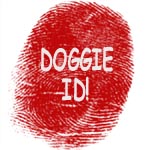WARNING! Once you microchip your dog and register the microchip, you have another step to go!! Please click on the print above to read more….
MICROCHIP YOUR DOG!

I’m lost and scared…I want to go home!”
The heartbreak of a lost dog can be devastating to the owner. There are an overwhelming number of dogs that end up in rescue and shelters and eventually with new owners or put down because the original owner could not be found. It is a good idea to do everything we can to provide the proper identification for our dogs in the event that they get lost.
The microchip is an advanced pet identification system. The microchip provides a permanent means of identification that remains in place. It cannot be altered or intentionally removed (without the services of a vet). A microchip with an identification code is implanted between the shoulder blades of the dog. It is about the size of a grain of rice. A licensed veterinarian or someone experienced (many breeders do this and help out at microchipping fairs) should do the microchipping. It is a simple procedure and is very similar to the administering of a vaccine. The chip is implanted under the skin between the shoulders of the dog. You cannot see the chip once it is implanted in the dog. Once implanted, any vet can read the chip I.D. number with a scanner. Note: Some vets have scanners that are not universal but their scanner should still be able to indicate the presence of a chip so you can go to another location where they have a universal scanner.) Thus leading to the return of the dog. All reputable breeders microchip their puppies before they are sold. Long-term testing has shown that the microchip is safe for your dog.
Once the dog is chipped, you fill out a simple form that your veterinarian provides and send it in with a check, usually under $15.00, to register the chip number. The information is then entered in a database. Changes in dog ownership are easily updated in a registry’s database. All Michigan Westie Rescue dogs are chipped before they are placed with their new owners.
Of course, all dogs should wear collar identification when not at home. There are a variety of dog tags ranging in price, and various types of tags such as the Pet Scope tags. Some people write their dogs information on a piece of tape inside the dogs collar. There are embroidered collars that you can put the dog’s name and telephone number on. (Many people feel you should not include the dog’s name since this is a piece of information which will assist you in proving ownership if a thief does not know the dog’s name. This is a call you must make for yourself.)
A LINK TO A VERY GOOD TAG SITE
COLLAR TAGS
However, tags and collars can come off. Tattooing dogs is another means of dog identification. Tattooing can blur over time, making it very difficult to read and a tattoo can be altered. If you do tattoo, make sure it is not done on an ear. Dog’s have had their ears cut off by dog thieves in order to remove the identification.
AVID MICROCHIPS
HOME AGAIN ID
Renewal fee is not required if basic package was purchased. Click on this example of the notice being sent to pet owners. Highlighted in yellow is the information which indicates that the pet is covered without paying an annual fee.
REMEMBER YOUR DOG IS YOUR RESPONSIBILITY. NEVER ALLOW THE DOG TO RUN FREE EXPOSING IT TO THE DANGER OF ACCIDENTS, THEFT AND ATTACKS FROM OTHER DOGS OR WILD ANIMALS.
LOST MY DOGGIE is a website to use when you are looking for your dog.

